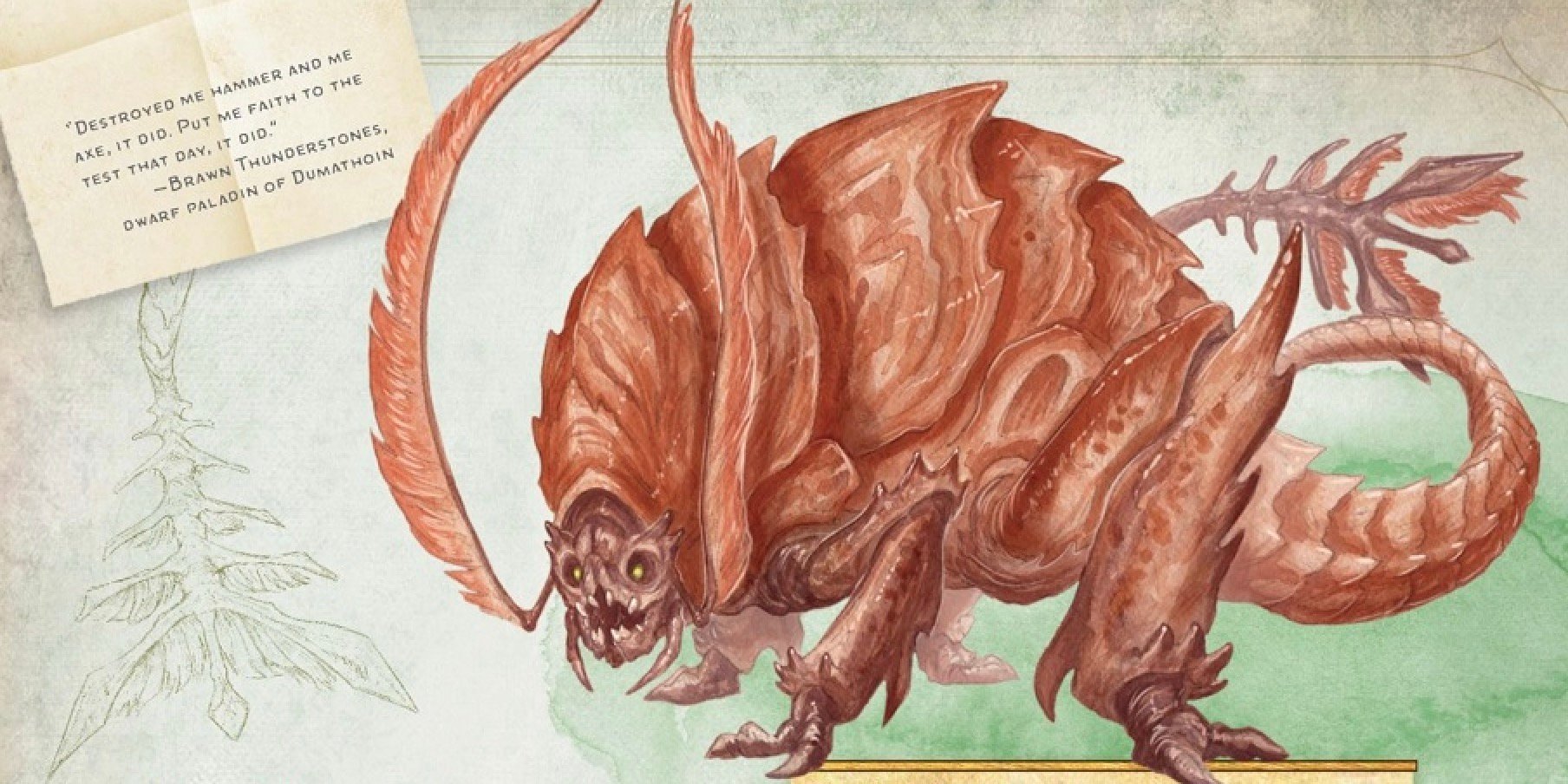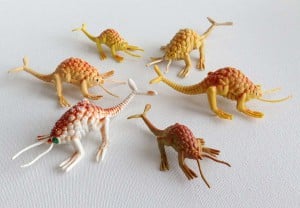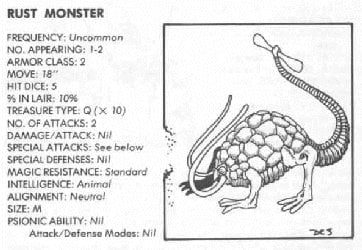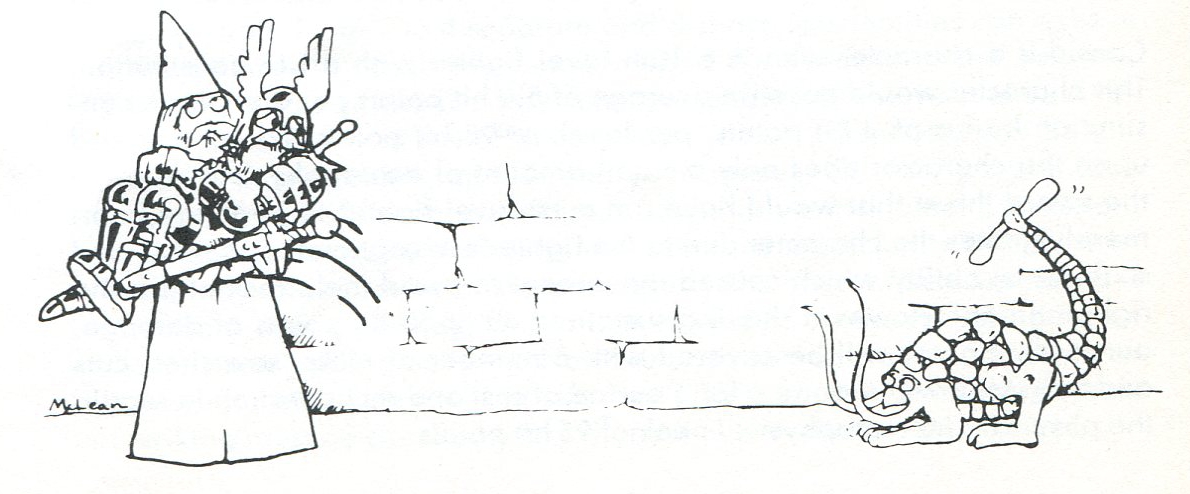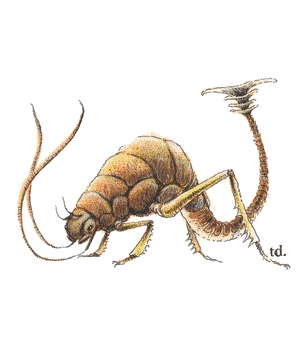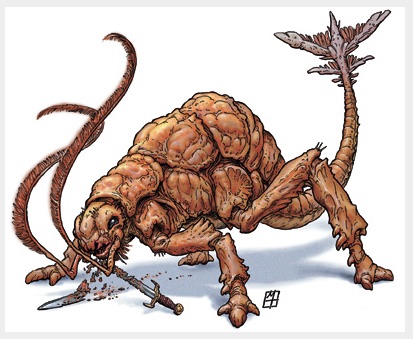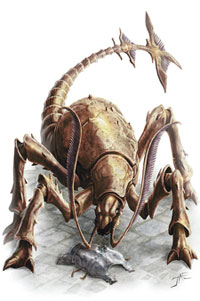Monster Spotlight: The Rust Monster


We’re a little rusty on the details of this week’s monster.
Time to lock away your swords, take off your armor and hide it in a closet somewhere, and make sure that if you have anything you want to keep around you you’ve got it stowed away safely in the overhead compartment, because this week we’re dragging the Rust Monster into the spotlight.
Oh dear it’s just eaten the chair.
Rust Monsters have been around since the very beginning of D&D. They’re one of the original gang of monsters developed from the package of plastic toys (including the Bulette and the Umber Hulk).
Just looking at them you can see that very little changed. The details have been perfectly captured, right down to the bone spur at the end of its tail (which does nothing in any edition). And like most of the monsters developed in the early days of D&D this one has a particularly Gygaxian feel to it. This thing doesn’t threaten the party’s lives… those are expendable. No, instead it hits them where it really hurts, their hard earned treasure.
And on that day, the Rust Monster proceeded to take its place in the annals of D&D History. Ever since then it’s been the terror of fighters, and the irksome pet of Wizards who want to mess with the party’s beefiest, plate-claddiest hero. I like what they represent in the game–there’s a tendency to have monsters always pose a threat to the character’s lives.
Which makes sense, this is a heroic fantasy game that’s descended from a wargame–but things like the Rust Monster take that focus away and add a different challenge. They change the stakes in a very real way for the players, and it can cause a different sort of dread. This is important. You need to be able to challenge your players and to threaten them/win without killing them all the time. Too much death (resurrection or not) and players will just lose any kind of dread from it. Classic “I showed up with five backup characters,” syndrome, which leads to a lack of engagement in the game.
But having an avenue to attack the players that doesn’t result in physical harm to their characters, but rather to their possessions only adds to the sense of immersion. It makes players feel the same concern that their characters are feeling, because nobody wants to erase those items right off of their character sheets–and here’s something that threatens to do just that. So with that in mind, let’s take a look at Rust Monsters throughout the ages.
1st Edition Rust Monsters were an absolute terror to the parties that would encounter them. So destructive they are literally breaking the 4th wall there–not even the almighty illustration box could contain them, they were ready to go and devour the goods of any hapless adventurers they’d come across. And go they did–with a move speed of 18″ (back in the day when you moved via measuring tape, they outpaced characters by a factor of 3.
Which, fun fact, did you know that, for the most part, characters in modern D&D are still just as fast as they were back in the olden days? That’s right. 30 feet = 6 squares, and on a one inch grid, that’s 6″ of movement. Time is a flat circle.
Back to our Corrosive Companion though–1st Ed. Rust Monsters would consume anything made of metal. Any kind of metal (though they had a preference for ferrous metals), and it didn’t matter if it were magical or not. A magic sword or piece of armor had some resistance to the rusting antennae, but it was only a 10% chance per plus to avoid the effect. Otherwise anything effected immediately dissolves into rust pieces. And you couldn’t even fight them–hitting them was just like getting their antennae all over your weapons.
And with some magic resistance and up to two of these appearing at a time, running into some of these monsters meant it’s time for the fighter to hide behind the wizard and the druid.
Rust Monsters also got an Ecology of… article in Dragon #88 which detailed their life cycle, and described them as being relentless in their pursuits, willing to tree adventurers, and even trying to knock them out of a tree with their “gallumphing” charges.
2nd Edition Rust Monsters are very much the same as their 1st edition kin. Though they definitely look more like insects here. Their artwork is much less cartoony–I love this adaptation. Even the bone spurs on the tail look phenomenal. 2nd Edition has some of the best takes on their monsters in general though. Maybe it’s just the coloring on this one–but it feels like something you could see running into in the dark places of the world.
The only big change, mechanically, is that they lost their magic resistance, which meant that Wizards had a slightly easier time beating up the big scary monsters so they could keep the fighters safe.
3rd Edition Rust Monsters got a little beefier in terms of their design. They look heavier–not as light or elegant as their 2nd edition counterparts–which I guess is okay, but that sleek design looks like something you’d see in nature–the plates are all bulbous and warped and zoomed in. The sword being devoured is a real nice touch though.
In this edition, Rust Monsters lost a little of their trademark speed, now only moving 30% faster than adventurers instead of a full 300%. They also lost a little of their power in the later edition, given how prevalent magic weapons and armor were in that edition. It’s a problem that any of the 3.x games have, you’re basically nothing if you don’t have at least a +1 by the time you’re level 4, and you’re expected to keep on going. So Rust Monsters (now a CR 3) lose a little of that terror.
The best/worst case for running into them is at low levels, when they are a threat to your fighter/paladin in full plate (1500 gp is nothing to sneeze at losing), buuuut once everyone starts wearing magic armor it could get a save, instead of the flat 10%-per-plus chance to not be dissolved, it had a DC 17 Dex Save to make. Which meant that as characters got higher level these became even less of a concern–we all know how easy it is for a 7-8th+ level character to make a DC 17 Reflex save. Which is fine–I mean these things are CR 3, you should stop running into them after a while–but it does take a little of the “gotcha” aspect of these guys out of the mix.
4th Edition Rust Monsters were in an interesting place. On the one hand, look at that picture–that looks like something that’s crawled out of my nightmares and is lurking under the bed right now. But also it looks kinda cute? So I could see keeping it as a pet and naming it Dr. Venture.
At any rate, 4th Edition made them more of a combat threat to a party of PCs, giving them a bite attack that actually deals serious damage. But in exchange, they gave up their core identity–its rust ability didn’t dissolve things instantly, instead inflicting the “rusting” condition which made weapons/armor take a cumulative -1 penalty (to a maximum of -5) to AC or Damage as appropriate.
True, they could still Dissolve Metal, but it was a standard action usable once per encounter, and if they ate a magic item, you would find the ‘residuum’ dust inside their bellies after you killed them. This change turned the idea of a rust monster on its head. Their whole thing was changing the dynamic of a combat because they threatened characters, but not their hit points.
This trend continues for 5th Edition Rust Monsters, though with a few key differences. Weapons and Armor and other metal items still gain the cumulative penalties associated with rusting, though they take a permanent -1 to either damage or AC and when this hits the specified limit, the item dissolves.
Attacking them is the riskiest prospect, as attacking them with a weapon guarantees that your weapon starts to rust–their own antennae action is much less accurate, requiring an attended object to fail a DC 11 Dexterity Save before they take any penalty. By and large, this shouldn’t be too difficult for players to accomplish–but I like the idea of permanent penalties and so on.
~At any rate, the Rust Monster has been a part of D&D History from day 1.

